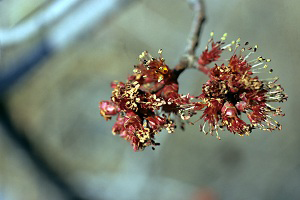This is one of the species in our North American forests that provides brilliant autumn coloring. The sap from this plant is suitable for syrup production, though the tapping season is shorter than sugar maple because of its earlier flowering.
Photo Credit: © Elaine Haug, USDA-NRCS PLANTS Database. Courtesy of Smithsonian Institution, Dept. of Systematic Biology, Botany.
Acer rubrum
Common Name: red maple
Plant Functional Group: Deciduous broadleaf
Class > Order > Family: Magnoliopsida > Sapindales > Sapindaceae
What does the species look like?
Red maple is a deciduous tree growing 30 to 90 feet tall. Its tiny, usually red, male and female flowers mostly occur separately on the same tree but occasionally can occur on different trees.
Red maple is often found in swamps and on moist soils, but can also thrive in drier habitats. It occurs on moist soils along stream banks, and in swamps, moist to drier woodlands, and occasionally on dry rocky hillsides and sand dunes. It is moderately shade-tolerant.
Where is the species found?
States & Provinces
AL, AR, CT, DC, DE, FL, GA, IA, IL, IN, KY, LA, MA, MD, ME, MI, MN, MO, MS, NB, NC, NH, NJ, NL, NS, NY, OH, OK, ON, PA, PE, QC, RI, SC, TN, TX, VA, VT, WI, WV
Special Considerations for Observing
If drought seems to be the cause of leaf color or fall for a plant, please make a comment about it for that observation.
This species has separate male and female flowers. If you know whether the flowers you are observing are male or female (or both), please make a comment about it for that observation.
Note that individuals of this species with only male flowers will not produce fruit.
Which phenophases should I observe?
Do you see...?
Leaves
Breaking leaf buds Acer rubrum , leaf tips may appear reddish.More...
How many buds are breaking?
Less than 3 3 to 10 11 to 100 101 to 1,000 1,001 to 10,000 More than 10,000
Leaves More...
What percentage of the potential canopy space is full with leaves? Ignore dead branches in your estimate of potential canopy space.
Less than 5% 5-24% 25-49% 50-74% 75-94% 95% or more
Increasing leaf size More...
What percentage of full size are most leaves?
Less than 25% 25-49% 50-74% 75-94% 95% or more
Colored leaves More...
What percentage of the potential canopy space is full with non-green leaf color? Ignore dead branches in your estimate of potential canopy space.
Less than 5% 5-24% 25-49% 50-74% 75-94% 95% or more
Falling leaves More...
Flowers
Flowers or flower buds More...
How many flowers and flower buds are present? For species in which individual flowers are clustered in flower heads, spikes or catkins (inflorescences), simply estimate the number of flower heads, spikes or catkins and not the number of individual flowers.
Less than 3 3 to 10 11 to 100 101 to 1,000 1,001 to 10,000 More than 10,000
Open flowers More...
What percentage of all fresh flowers (buds plus unopened plus open) on the plant are open? For species in which individual flowers are clustered in flower heads, spikes or catkins (inflorescences), estimate the percentage of all individual flowers that are open.
Less than 5% 5-24% 25-49% 50-74% 75-94% 95% or more
Pollen release More...
How much pollen is released?
Little: Only a few grains are released. Some: Many grains are released. Lots: A layer of pollen covers your palm, or a cloud of pollen can be seen in the air when the wind blows
Fruits
Fruits Acer rubrum , the fruit is two joined seeds in a "V" shape, each seed having a wing, that changes from green or red to tan or brownish and drops from the plant.More...
How many fruits are present?
Less than 3 3 to 10 11 to 100 101 to 1,000 1,001 to 10,000 More than 10,000
Ripe fruits Acer rubrum , a fruit is considered ripe when it has turned tan or brownish and readily drops from the plant when touched.More...
What percentage of all fruits (unripe plus ripe) on the plant are ripe?
Less than 5% 5-24% 25-49% 50-74% 75-94% 95% or more
Recent fruit or seed drop More...
How many mature fruits have dropped seeds or have completely dropped or been removed from the plant since your last visit?
Less than 3 3 to 10 11 to 100 101 to 1,000 1,001 to 10,000 More than 10,000
What do these phenophases look like?
The following Phenophase Photo Guides for this species have been vetted for accuracy by the USA-NPN National Coordinating Office. Most photo guides are developed for a particular local or regional monitoring effort, and some of the content may not apply to your effort or your region. However, we make them available to provide as much help as they may in illustrating phenophases for this species. If you have high quality phenophase photos that you are willing to share with us, please visit the Phenophase Photo Guidelines page.
Be aware there is variation from individual to individual within a species, especially across different regions, so your plant may not look exactly like the one pictured.
Since they do not always include complete definitions for the species, use these photo guides ONLY in conjunction with the official Nature's Notebook phenophase defintions included in the table above, in the phenophase definition sheet that downloads with the datasheet, or in the Observe screen in the mobile app.
